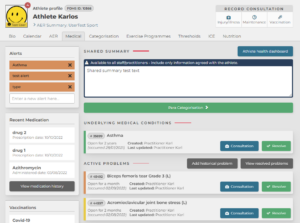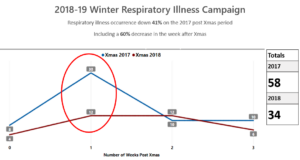How Performance Data became a focal point of the EIS Athlete Health strategy
The Performance Data team at the English Institute of Sport (EIS) enable and empower people to create performance insight from data. This story explains how Performance Data helped Craig Ranson – Director of Athlete Health at the EIS – to do just that, and build a world-leading Athlete Health Intelligence system. That system has spawned numerous Athlete Health initiatives which have had a positive impact on athletes’ health and performance.
Craig Ranson has been Director of Health at the EIS since 2017, with a remit of supporting sports’ management of athlete physical and mental health. Anyone who follows high-performance sport knows what a large impact injury and illness can have on athletes’ availability, and having athletes available for selection when it matters most is at the heart of the EIS Athlete Health Strategy.
Ranson said: “When I first became the EIS Director of Athlete Health, the service delivered by the EIS was highly rated by sports, but there was little basic information available to quantify the injury and illness burden across Olympic and Paralympic sport.
“It was impossible to find the data to inform decisions such as where the EIS should focus its resources in terms of Athlete Health research, recruitment, development and projects. There’s no doubt that EIS service delivery was having a big impact on athlete health, but finding quantifiable data to evidence this was a challenge. It was these circumstances that led to the UK embarking on a journey to lead the world in Athlete Health data.”
The project approach
Athlete Health engaged with the Performance Data team to help them in their mission, and together they identified three steps that needed to happen.
1. Create sustainable infrastructure
Athlete medical records would be at the heart of the solution, so the EIS created from scratch a bespoke Performance Data Management System (PDMS), which enables the core processes and key data capture for doctors and physiotherapists.
Athlete-reported wellness and training was also prioritised to gather data on availability and key health and performance factors such as sleep and training load. Finally, Operations were considered from the start, ensuring effective support for users and appropriate data protection, data quality and medical governance.
David Gallimore, Head of Performance Data, explained: “The EIS had never attempted a project like this, and we faced significant resource and time pressure. It was important to secure stakeholder buy-in by demonstrating rapid progress – replacing the legacy medical records system in the first year – while at the same time continuously invest in our capability to achieve the long-term vision.”

2. Transform into insight
Capturing quality, sustainable data is the foundation, but to realise the untapped potential of system-wide Athlete Health data it first had to be transformed into valuable insight. There were significant challenges to overcome and lessons to learn along the way.
Producing insight from such a large and complex dataset required yet more specialist skillsets – Business Intelligence Developers and Data Scientists, guided by experienced Athlete Health practitioners who generated the right questions at the right time.
Joshua Wass, Performance Data Lead, said: “The Covid-19 pandemic highlighted how far the team had progressed. Everything that had come before – athlete wellness monitoring, medical records, reporting infrastructure and development of the team – enabled us to quickly respond, creating a Covid monitoring dashboard for medical staff in all sports to monitor athlete status and make return to training decisions – rolled out in just a few weeks.”
3. Join data to action
If the purpose of data is action, then making sure there is a strong connection between the two is fundamental in making the journey worthwhile.
Athlete Health have a ‘one strategy, one team’ mantra which aligns medical practitioner service delivery with central Athlete Health support, and makes performance data a cornerstone of decision-making. Data feeds into all pillars of the EIS approach to help sports plan their individual Athlete Health strategy and inform system-wide learning projects.
The project impact
The impact of the Athlete Health Intelligence System can be seen in one large scale, vital respiratory health project.
Respiratory Health was a significant focus for Athlete Health during the Tokyo 2020 cycle. Performance Data was able to tell them that, over the last five or so years, almost 2,500 respiratory illnesses have impacted over 20,000 days of training and competition for around 1,000 athletes, and that this represents the most significant health burden to the UK high-performance system.
As a result of this insight, a major project was initiated to identify risk factors and optimise respiratory health management in those identified as ‘susceptible’.
Ranson said: “Performance Data worked with us to review our PDMS Data in 2017. It was immediately obvious that respiratory illness was the health problem responsible for the most lost preparation and performance time across the system, and if there was only one thing to tackle this cycle it would have to be respiratory health.
“A large-scale collaboration between the EIS, ISEH [Institute of Sport, Exercise and Health], Imperial College London, the Royal Brompton Hospital and all high-performance sports produced several initiatives that have reduced the burden of respiratory illness.
“First, a project to use PDMS data to identify around 200 athletes susceptible to respiratory illness and provide a systematic assessment service to them and their doctors aimed at optimising their care.
“Supplementary, innovative winter illness campaigns in 2018 and 2019 significantly reduced the typically high New Year time loss seen in previous years, and overall respiratory illness burden has fallen from around nine days restriction per occurrence at the start of the cycle to less than six days now.
“The bottom line is that athletes are more available to train and are less likely to have performance compromised by illness.”

Gallimore added: “We have already come so far and yet the journey is just getting started. The systems, tools and most importantly people are now set up to enable the efficient and effective communication of information vital to understand the biggest health challenges to athlete wellbeing and performance, so that health and performance planning can be integrated and optimised.”
For more information on Athlete Health at the EIS, visit this page, and to find out more about Performance Data, click here.